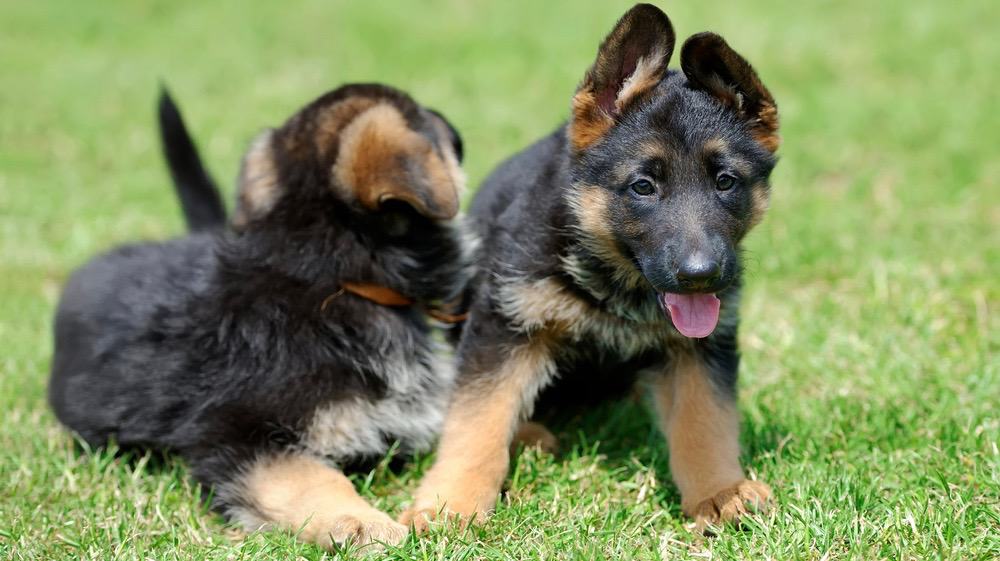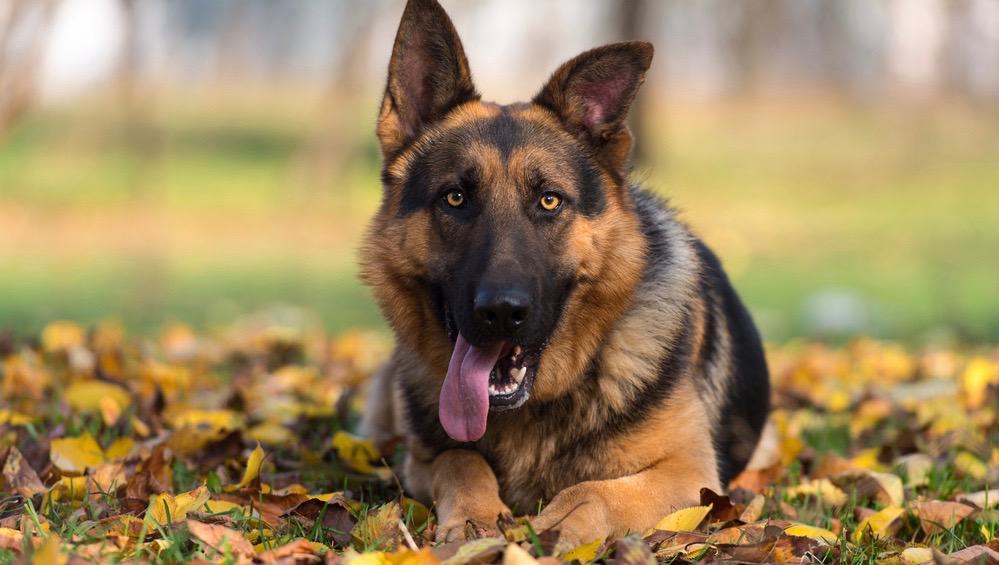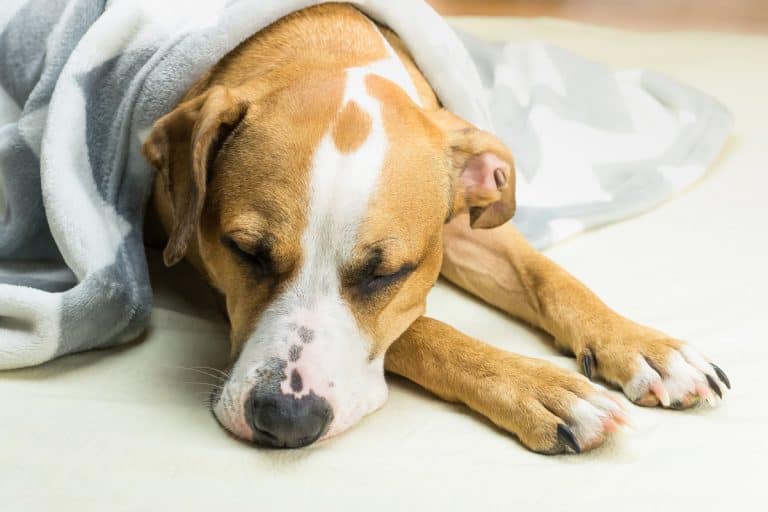When Do German Shepherd Ears Stand Up?
Large pointy ears are one of the most distinctive features of the German Shepherd dog, and most owners wait for this moment. So, when do German Shepherd puppy ears stand up?
On average, German Shepherd ears are erect between the ages of 4 and 5 months. The ears will only stand when the small bones and cartilage have developed enough.
Most German Shepherd dog owners worry and become anxious when their puppy’s ears do not stand up the right way.
This article will give you more information on when your German Shepherd’s ears will stand up, what causes them to have floppy ears, and how you can help their ears stand up.
German Shepherd Puppy Ear Stages

The ears of German Shepherds can be unpredictable; therefore, it is important to note that your puppy’s ears may not follow the stages. When do German Shepherd puppy ears stand up?
Be patient and give time for your puppy’s ears to develop. The following are the German Shepherd puppy ears stages to be aware of:
Newborn to 5 months
Teething begins when your puppy is around 3 months old, and it is common for its standing ear to go up and go down again. When teething is over, the ears should stand back up.
5 to 6 months
When your German Shepherd pup is around 5 months old, usually teething is complete, and their ears may be standing already. However, they may not be standing strong yet.
6 to 8 months
If your puppy is in this stage and their ears have not stood up yet, you need to be concerned. Most puppy ears should be perky and nice by now.
After the age of 6 months, you should talk to your breeder or vet to get advice on how you can help your puppy’s ears stand up. After 8 months, the chance of your puppy’s ears ever standing up reduces significantly.
When Do German Shepherd Puppies Ears Stand Up?
Most German Shepherds’ ears will stand up between the ages of 4 and 5 months. However, the ears can stand up later or earlier than this age. This is the standard advice and rough timeline that breeders give out.

Why Does Your German Shepherd Have One Ear Up and One Ear Down?
In the early stages, it is common to see the ears of your GSD pup dancing around, and you will likely see one ear standing up first and then flopping back again.
When you notice that the right and left ears alternate between flopping down and standing up, there is no need to worry, as this is normal. Some dogs simply have large ears that fall down the face and are floppy, while others have ears that are upright or semi-pricked.
However, this is rare but is often determined by genetics in the same way their coat length, eye color, and coat color are.
In the early stages, it is common to see ears dancing around and you will likely see one ear standing up first and then flops back again.
When you notice that the right and left ears alternate between flopping down and standing up, there is no need to worry as this is normal.
The German Shepherd Ear Standard
The first impression you should receive from a German Shepherd is that it is agile, strong, muscular, full of life, and alert. This is according to the American Kennel Club.
The ears play an important role in giving this breed their state of vivid alertness as they are ready to rotate in any direction and have a touch of nobility.
The ears of German Shepherds should be moderately pointed and erect when attentive. When viewed from the front, the ears’ center lines should appear perpendicular to the ground and parallel to each other.
You may be concerned if the ears of your German Shepherd are floppy and have no sign of standing up anytime soon, especially if you know that they will be disqualified from the show ring.
However, if you do not intend to show your puppy in conformation rings but want them to just be companions, there is no need to be concerned. Most puppies will outgrow their floppy stage, and their ears will eventually stand up.
What Causes German Shepherds To Have Floppy Ears?

When German Shepherds are puppies, their ears are floppy and small and fold over to the front side. This can be a concern, especially if you are a new puppy owner expecting your German Shepherd’s ears to be upright when floppy.
The following are the reasons why your German Shepherd’s puppy ears are floppy:
Teething
This is the main reason your German Shepherd puppy has floppy ears. All puppies go through this grueling process which usually begins around the age of 4 weeks and can last up to 6 months.
Teething hugely affects ear development because the neck and jaw muscles are responsible for perky and healthy ears apart from the cartilage and ear muscles.
During teething, a considerable amount of new pressure and stress is applied to the mouth, neck, and jaw, so ear development takes a back seat until the process is over.
The ears flop down and stand up as the intensiveness of teething fluctuates. Therefore, sometimes the ears dance around; one day, they are down, and the next, they are up.
Usually, it coincides with how much physical stress is caused and the teething process.
Developing Cartilage
Floppy ears can also be caused by developing or weak cartilage. Small bones and cartilage make the ears stand up, and since German Shepherds have big ears, the cartilage needs to be strong and healthy to carry the ears’ weight.
Weak cartilage can be due to injury when playing or someone touching the ears a lot. You should avoid fondling their ears despite their cuteness to ensure they are not weakened or accidentally damaged.
Damage Or Accidents
Since your puppy’s ears develop from birth until the age of 5 months, they can be damaged or become droopy if there is any trauma.
Puppies are also mischievous and rambunctious and find trouble easily. Sometimes this curiosity can lead to physical damage to their ears or an accident that can hurt the cartilage or muscle. If there is an accident or damage, it could ultimately cause long-term damage, and your dog’s ears may never stand up.
To protect their ears, never tug, pull, or twist them and be careful of the ears during playtime. Even rough play between your dog and other dogs can result in injury. For instance, if another dog pulls or bites your puppy’s ears or the kids love yanking or tugging on the floppy ears, all this can lead to significant damage.
If your dog has gotten into an accident, immediately take them to the vet. Advise everyone to avoid touching these adorable ears as much as possible to ensure they stand strong and develop correctly.
Breeding And Genetics
Genetics affects dogs the same way it affects humans. The physical traits of parents can be passed down to the puppies.
Therefore, look at the mother and father of your German Shepherd so that you can have an idea of what to expect, whether they are perky or not, their shape, and their size.
You should note that some variations of the German Shepherd breed have floppy ears throughout their life.
If your puppy is mixed, the chance of them having floppy ears is high. However, purebreds have triangular-shaped and erect ears.
Parasites
Parasites affect puppies, especially those that like playing in dirty places and eating things they are not supposed to. Parasites impact your puppy’s development by draining the nutrients they need. Check their poop for any signs of worms that may be taking away their nutrition.
The inflammation from ear mites can cause droopiness in the ear with the infestation. However, ear mites often affect both ears at the same time. You may notice excessive itchiness, redness, bleeding, and swelling because your German Shepherd pup constantly scratches its ears.
Poor and Improper Nutrition
German Shepherds need balanced and complete nutrition, especially during the growing stages, including minerals and vitamins that help develop muscle and ear cartilage.
Poor nutrition can affect ear development by not providing the right building blocks needed for growth.
Neglecting Ear Cleaning
Dirty ears can prevent proper growth and make your dog feel uncomfortable, causing them to scratch excessively, leading to damage.
When cleaning your dog’s ears, do not stick anything in the ear canal; instead, wipe the dirt using special ear cleaning wipes or a warm washcloth.
How To Help Your German Shepherd’s Ears To Stand Up

The following are the ways you can help your puppy’s ears stand up:
Chew Toys
Chew toys are valuable during the teething phase. During teething, your German Shepherd is inclined to chew on anything they can find because this promotes blood flow to the gums and relieves your puppy’s pain. When chewing, your puppy will develop its temporalis muscle. This is the muscle responsible for holding up their ears.
Buy high-quality chew toys to prevent your puppy from chewing on your furniture, and ensure that you rotate them weekly. This will keep your German Shepherd excited because they will think it is a new toy even if they have already used it.
Apart from helping with teething, a chew toy supports ear development by building and strengthening the neck and jaw muscles that play a key role in the overall ear structure and growth.
Provide Them With Healthy Antioxidants
Vitamin C is found in many antioxidants. This can reduce stress on your puppy’s body, which can help them grow ear cartilage. Treats high in antioxidants you can give them include watermelon, sweet potatoes, celery, carrots, apples, and pumpkin.
Nutrition
The nutrition and food your German Shepherd puppy eats are important in every part of its growth and development, including the ears.
Ensure that the food your puppy feeds on is high in protein sourced from whole meat, rich in healthy fats, and contains a variety of vegetables and fruits for antioxidants, minerals, and vitamins.
Buying dog food from a trusted and reputable brand will ensure that you are not feeding your puppy cheap and unhealthy ingredients.
Choose products specifically designed for puppies as they contain formulas that provide the necessary nutrition your puppy needs for their growth and development.
Some food that may help your puppy’s ears stand up includes yogurt, cottage cheese, and chicken feet. Yogurt and cottage cheese contain calcium, while chicken feet contain glucosamine, which helps make the cartilage strong.
Don’t Touch Or Fondle The Ears
Puppy’s ears are always adorable and irresistible that you want to touch them, but this is not advised at all. Too much fondling weakens the bones and cartilage that are not yet developed or strong.
The touching and fondling will not only extend the time for the ears to stand up but may cause permanent damage.
Some breeders advise that you can massage the base of the ear gently to encourage blood flow, but if you are not sure, avoid the ears.

Be Careful With Glucosamine
Glucosamine is a supplement that can be found over the counter and is used by humans to keep joints lubricated and maintain healthy cartilage, but it is also used in dogs.
However, you should speak to your vet before giving your puppy glucosamine.
Avoid Supplementing With Calcium
Calcium is good for bone and tooth development, not cartilage. When your dog has too much calcium, it results in an imbalance of the minerals they need, as well as cause serious health problems. Instead of calcium supplementation, just make sure your GSD gets a proper diet with the right nutrition.
Taping German Shepherd’s Ears
Ear taping is usually the last effort to help your German Shepherd’s ears stand up and prevent droopy ears. Taping is easy and requires only a few items, including foam rollers, clean popsicle sticks, and self-adhering waterproof dog wrap.
The following are the steps to tape your puppy’s ears:
Placing The Form Roller Inside The Ear
Remove the plastic clip in the foam roller and place it gently against the inside skin of your puppy’s ears.
Do not push the roller inside the ear; it only needs to be placed inside the ear enough to support the growth of the cartilage. Ensure that there are no folds or creases in the ears before doing the next step.
Make A Popsicle Support
Take the popsicle sticks and put them on top of the foam rollers (both ears should have the foam rollers). You may need help from a family member or friend to do this.
Next, take a medium-sized self-adhering waterproof tape and place it around and across the popsicle sticks and the two foam rollers. This creates a bridge between the two ears to help support and align them together. This ensures symmetrical and even growth.
Remove And Inspect Their Ears Weekly
Select a day in the week when you remove the wrapping and foam rollers and see whether the ears are standing naturally on their own. Also, check if there is any soreness from improper taping.
If the ears stand on their own, then do not tape them. However, if the ears flop down, tape them again to provide more support for a bit longer.
Ensure that you check them weekly to see the health of your puppy’s ears.
When To Stop Taping
When your German Shepherd reaches the age of 9 months, their ears should stand on their own without the need to be taped. If your puppy is 9 months and their ears are still floppy, visit the vet for help.
This could mean that your German Shepherd’s ears might stay floppy permanently, and there is no need to worry.
Is Taping A German Shepherd’s Ears Bad For Them?
Taping is not bad if you use the right tape to make your German Shepherd’s ears stand up. However, taping can be bad and unhealthy if you injure their ears by not properly taping them or inserting the foam rollers too far into the canal.
If you are unsure, ask your vet to show you how to tape the ears of your GSD puppy.
Your German Shepherd puppy may become annoyed and uncomfortable with the tape on their ears, but they will forget that they have it in no time.
They need some distraction and close supervision during the process.
Can You Use Surgical Implants for Your German Shepherd’s Ears?
There have been instances where surgical ear implants have been used to restore a German Shepherd’s ears. The implant, created by Gregg Miller, is three inches by four inches and is said to be paper thin and lightweight. Surgical mesh is welded over a plastic spine, allowing tissue growth in the dog’s ear. This will begin happening just ten days following the implantation.
Health Concerns Associated With Floppy Ears On A German Shepherd

When your German Shepherd’s ears are floppy, there is less air flowing through the ears, meaning more moisture accumulates. This leads to the following health issues:
- Increased risk of ear infection – the moisture and heat trapped inside your puppy’s floppy ears increases the risk of ear infection even with frequent cleaning.
- Increased risk of ear injuries – if your puppy has floppy ears, they are vulnerable to potential harm because their ears are more likely to get torn and bitten or get in something when fighting or playing.
- Increased risk of hearing damage – if your puppy’s ear injury or damage is severe, they could experience hearing damage or total hearing loss in the long run.
- Need for more frequent cleaning – whether your puppy’s ears are pointed or not, they need cleaning. However, if your dog has floppy ears, they need to be cleaned more often than those dogs with pointy ears.
What Do German Shepherd Ear Positions Mean?
- Ears up and down – this is how your puppy offers their greetings to other pets and people. It may be accompanied by face-licking and tail-wagging.
- Floppy and relaxed ears – this means that your dog is completely relaxed and not stressed.
- Forward-tilted ears – your dog is trying to tell you that they are alert and confident, which is mostly associated with an attitude of being self-assured.
- Backward-tilted ears – your dog might be feeling fear or anxiety, especially when training them to show submission.
- Constantly tilting ears in different directions – your dog could be trying to figure out where the noise comes from.
Taking Care of Your German Shepherd’s Ears
You should regularly examine and care for your German Shepherd’s ears like other dogs. Examine the ears once per week and remove the dirt, waxy buildup, or debris using an ear cleaning solution approved by the vet.
To clean the ears, squeeze a few drops of the cleaning solution into the canal. Then wipe the dirt and any excess solution using a cotton ball. Don’t push anything inside the ear or use ear swabs, as they could lead to deafness or injury.
You can ask your vet to clean your puppy’s ears if you are uncomfortable doing it.
Final Words
Your German Shepherd’s ears will stand up at around 5 months. Some may take longer, while others may be earlier. Genetics, teething, cartilage, and nutrition are some of the factors that can affect when your puppy’s ears stand up.
Ensuring that your puppy gets the proper nutrition, chews on high-quality toys, and that their ears are not touched during the growth stages will help their ears stand up. Taping is also another way of helping your puppy’s ears erect.
Before deciding on the health of your puppy’s ears, you must consult with your vet.






